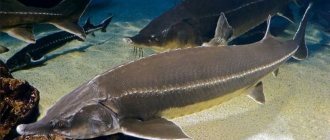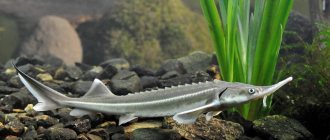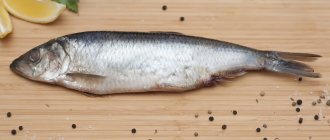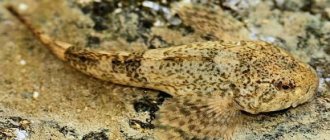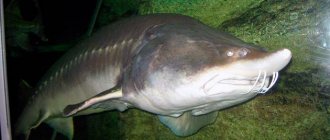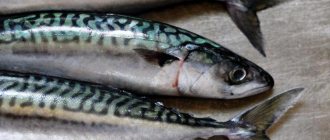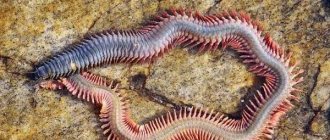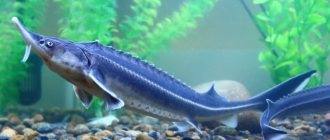Everyone loves red fish; it is considered the most delicious and dietary. But most people don't understand which one to call salmon. In fact, it is a collective concept that describes the common characteristics of several varieties. There is no such fish as salmon, but even scientists often call some species this way.
| Class | Ray-finned fish |
| Squad | Salmonidae |
| Family | Salmonidae, subfamily - salmonids |
| Genus | Lenki, Pacific salmon, noble salmon, char |
| View | Lenok, sockeye salmon, salmon, chum salmon, taimen, char, coho salmon, pink salmon, chinook salmon |
| Security status | Not endangered, but fishing is prohibited in some places |
| Size | Up to 1.5 m, up to 30 kg |
| Lifespan | 15 years |
| What does it eat? | Invertebrates, small fish, insects, caviar |
| Optimal feeding time | Spring and early summer, cloudy weather with a small wave, daylight |
| Enemies | Unknown |
| What do they bite on? | Spoons, wobblers, flies |
What is salmon called?
Red fish is very popular; not a single feast is complete without it. Many people call all its varieties salmon, but does such a fish really exist? In general, the word “salmon” is a collective concept, just like “trout”. There are no such fish in science, but this word is used to describe some species of salmon.
The word “salmon” is very ancient; in Indo-European it meant “to be speckled.” But these fish were not called that right away. The first classifications of ray-finned fish included them in the herring family.
Now there is a separate salmon family, which is divided into 3 subfamilies: whitefish, grayling and salmon itself. It is representatives of this subfamily that are often called salmon.
Salmon diet
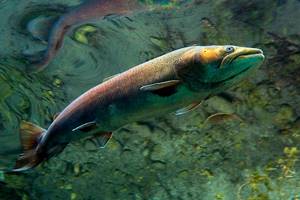
The usual diet for Salmonids is quite varied. As a rule, small pelagic fish and their juveniles, as well as various crustaceans, pelagic pteropods, squid juveniles and worms are found in the stomachs of adult individuals. Somewhat less often, small ctenophores and jellyfish are included in the food of adult fish.
For example, the main food for juvenile salmon is most often represented by the larvae of a wide variety of aquatic insects. However, the parr is quite capable of feeding, along with other predatory fish, on loaches, sculpins and many species of small fish. The diet of salmon can vary markedly depending on the time of year and the characteristics of their habitat.
A species of fish of the salmon subfamily
There are many classifications of salmon, and sometimes even scientists get confused. Most often, all these fish are divided into three groups:
- Pacific salmon - chum salmon, pink salmon, chinook salmon, sockeye salmon, coho salmon;
- noble salmon - salmon, trout;
- loaches.
The most common are the first two, which have this word in their names. This is what they often call any variety, without understanding what the difference is between them. This word is often used instead of the name salmon. Therefore, the question of how salmon and salmon differ is incorrect.
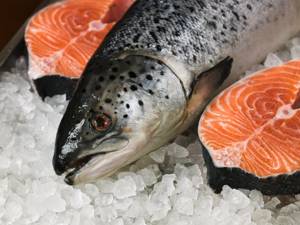
All species of salmon have some peculiarities of appearance and behavior. But only a specialist can understand whether they are different from each other. For ordinary people, this is all salmon.
- Salmon is the largest fish of this family. It grows more than a meter long, up to 45 kg. What else is the difference between salmon and salmon: its body is silvery, there are very few dark spots.
- Pink salmon are easily identified by their characteristic pattern of many spots. It is small, growing no more than 70 cm. It is especially easy to see the difference between pink salmon and salmon during spawning. At this time, the male becomes hunchbacked and his teeth grow.
- Chum salmon has the most tender dietary meat. She has medium size, small eyes, an elongated body with light gray scales.
- It is easy to understand how sockeye salmon differs from other salmon. She has meat and almost the entire body is bright red.
- Coho salmon is a small fish with a beautiful silver color. But during spawning it can also turn red.
- Chinook salmon is the largest of the salmon subfamily. She grows up to 50 kg. Chinook salmon meat is very tasty and has valuable nutritional qualities. A distinctive feature is clearly defined gill stripes.
Trout is classified as a separate species, but this is also a collective concept. There are several varieties depending on their habitat and color. There are Adriatic trout, lake trout, rainbow trout, Arizona trout, golden trout, Sevan trout and others.
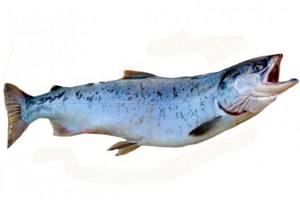
This is also a valuable commercial fish, so many are interested in the question of how trout differs from salmon. First of all, it is smaller, never growing more than 4 kg. In addition, she has a beautiful coloring with spots, sometimes multi-colored, and there is a pink stripe along the body.
Salmon. Description and general characteristics
A predatory fish, a representative of the salmon family. Another name for sea salmon in some regions is salmon. This species is widespread in the Atlantic and Arctic oceans; it can also be found in the White and Baltic seas.
- Salmon fish
- Origin
- Description
- Life cycle
- Spawning
- Classification
- Salmon subfamily
- Subfamily whitefish
- Grayling subfamily
- Fishing Features
- Links
- Video
The average weight of individuals ranges from 8 kilograms, although some can weigh more than 30 kg. Salmon spawn in the river basins: Neva, Kola, Northern Dvina and many others. In the Black Sea waters there is a species of salmon that looks similar to trout. It can weigh up to 7 kilograms, in rare cases it grows to 24. Caspian salmon , weighing on average 14 kg. It spawns in the flowing rivers - Kura, Terek, Svir. The weight of lake salmon is much smaller than other species and reaches an average of 4 kilograms, with a maximum of 12. Salmon is a typical representative of migratory fish. It constantly lives in lakes or seas; only for the purpose of reproduction does the fish rise up the rivers.
Salmon fish
The name Salmon fits a whole species family of fish of different shapes and sizes. Without being an ichthyologist, it is difficult to figure out what is a “red fish” and what is not. We will try to answer all questions related to salmon. This is not a specific name, but several species combined into one group family. The definition includes several subspecies with different representatives of shape and size.
Most often, when people mention salmon, they mean two main genera of the salmon family, namely : - Pacific - the genus is determined by its habitat in the Pacific Ocean; pink salmon, sockeye salmon and chum salmon can be considered prominent representatives; - noble - most often found under the name salmon, this is what is meant in most cases when saying salmon.
Often this word is included in the full name of an individual, taking into account its characteristics. For example, Atlantic or steelhead salmon. Having found out that it is a group family, and not a specific species, that falls under the definition, it is worth learning in more detail everything related to this name.
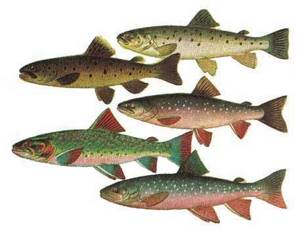
Origin
Pisces are one of the first representatives of life, dating back to the beginnings of history. There is no specific data yet on the formation of a specific form. Scientists often argue about which species a particular animal is a representative of. Salmonids are no exception, due to their close similarity in structure to herrings. This caused a number of travelers. There are even classifications where both of these families are on the same row.
According to the research and assumptions of ichthyologists, salmon began its history approximately 145 million years BC. These figures date back to a distant ancestor, while the division into families occurred much later, presumably in the period from 62 to 25 million years BC. The word itself comes from the Indo-European "lak" - meaning spotted or sprinkled. This root is present in Old Church Slavonic, from which the modern sound comes, “lak'-so-s”. It turns out that the word “salmon” meant the presence of dark spots on the appearance.
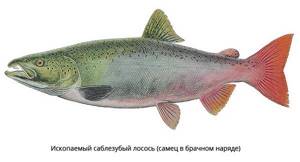
Description
Salmonids have certain common features by which they are recognized : - the presence of an adipose fin, without rays; - the ability to change color and appearance depending on living conditions.
In general, individuals have an oblong body shape, covered with scales from tail to head, and a bare head without antennae. There is a lateral line - a key feature of the structure.
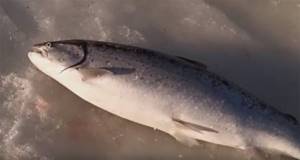
Location of fins : - ventral fins are located in the middle part of the belly; they have 6 rays or more; — in the lower position of the chest there are pectoral fins without rays; - true dorsal fin on the central part of the back, with ten or more rays; - adipose fin, located immediately behind the real dorsal fin, without rays; - anal fin - opposite the adipose fin.
The skull is not always bone; a large area may have a cartilaginous base. The mouth is bordered by two pairs of bones, the maxillary and the anterior maxillary.
The total length of a representative of this family may vary, some specimens grow up to 2 meters. According to size, the average weight reaches 70 kg; certain representatives have broken this record. Small individuals live from 2 to 5 years, large ones - up to 15 years.
The record holder in size and life expectancy is taimen. According to studies, he lived more than 50 years. It was 2.5 m long and weighed more than 100 kg.
Life cycle
The diversity of the family includes both freshwater salmon and anadromous ones. Due to the fact that spawning always occurs in fresh water, each subspecies behaves differently.
Some remain in the same body of water from the moment they hatch from eggs. Later they spend their lives in it. These forms of the family are usually called residential.
Anadromous - from the moment of hatching, they are sent to the salty waters of the seas, carried by the current, where they grow into adult fish and return to die.
Migratory and resident fry feed on various insects and eggs of small fish. Once in the sea, large representatives become hunters for all kinds of schooling little things and non-vertebrates. Adults spend most of their lives in sea waters, where they gain weight by actively feeding. Only after reaching an “advanced” age do they return to their native reservoirs to spawn.
Spawning
Migratory salmon, for the most part, give birth only once in their entire lives, dying after laying eggs. Exceptions occur among salmon; some representatives of this species spawn up to four times. But these are rare cases that confirm the general rule.
Significant changes occur with chum salmon, pink salmon and other representatives before being sent to spawn. The inside of the body and the outside undergo metamorphosis.
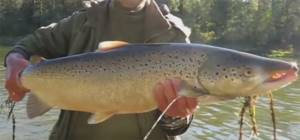
The body changes color, bright colors appear, silver disappears, black or red spots appear. Males may begin to develop a hump in the back area. Pink salmon got its name precisely because of this feature. The jaws also undergo changes, becoming hook-shaped and the teeth more rounded.
At the same time, internal organs change, the intestines, stomach, and liver degenerate. Muscle tissue becomes more elastic and fatty, and as a result, the meat loses color and taste.
Classification
The family is divided into three subfamilies, namely : - salmonids ; - whitefish ; - grayling .
In addition, a division is carried out according to generic affiliation : - Pacific - the main habitat follows from the name. They have small to medium sized scales. The eggs are orange in color. The key feature is death after spawning. Representatives are pink salmon, chinook salmon, chum salmon, sockeye salmon, and coho salmon. - True salmon have fewer rays on their fins; juveniles have teeth in the back of the mouth. Despite the change in color during the mating season, they do not die during the spawning period. Habitats: Pacific and Atlantic Oceans. Not uncommonly found in: the Aral, Baltic, Black, Caspian seas. They are characterized by the rich color of their scales. — Loaches are a variety that got its name due to its appearance. Very small scales create the feeling of their complete absence. Their order includes dozens of varieties; they can be residential or migratory.
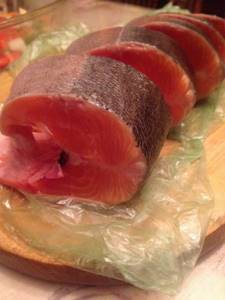
Trout (Latin trutta) is a collective name. Unites several species of fish of the same family.
Salmon subfamily
Ray-finned fish belonging to the salmon family are bright representatives of their species, with all the distinctive features. For the most part, fishing is carried out on them, occupying leading and priority positions. It is impossible not to note the taste qualities of salmon, recognized throughout the world.
Pink salmon is the most striking example. Habitats: the waters of the Pacific Ocean, the northern latitudes of the Sea of Japan and the Sea of Okhotsk, and the shores of Kamchatka. It is relatively small and reaches a length of no more than 76 cm, with a maximum weight of 5.5 kg. Appearance changes depending on the habitat, for example, being in open sea waters, the scales become light and acquire distinct dark spots. Like all passersby, spawning time calls for obvious changes. Pink salmon, descending into rivers, acquire a brown tint, and the head and fins turn black. During the spawning period, males grow a very noticeable hump and modify their jaw.
The salmon subfamily also includes: chum salmon, sockeye salmon, coho salmon, chinook salmon, salmon, kuzhma, lake trout, char and others.
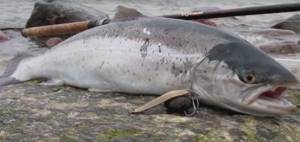
Subfamily whitefish
Whitefishes are more than forty species, the key features of which are : - body pressed to the sides; - small head; - geometrically round large eyes; - small mouth. Whitefish have silvery scales ranging from bluish-green to brown. They can grow to quite impressive lengths and weigh more than ten kilograms. The habitat is very wide from the northern part of America to Asia, while whitefish love clean and cold water. Whitefishes are predators that hunt in the crosshairs of water currents, preferring depths and depressions.
Representatives of whitefish are: nelma, muksun, omul, peled, European vendace, Siberian vendace, Ussuri whitefish, whitefish, tugun and others.
Grayling subfamily
A subfamily of very beautiful fish. Many ichthyologists separate graylings from salmonids, considering them separate .
The appearance of grayling varies greatly depending on the body of water. Usually the back is dark green, gray-green, with a pronounced dorsal fin with many rays, up to 24 pieces. The body and peritoneum are lighter, there are longitudinal stripes from head to tail.
A distinctive feature of grayling is the dorsal fin, bright and massive. Grayling is not a large individual, although it has set weight records of more than 6.5 kg; tails weighing 1-2 kg are more common.
He prefers clean and cold waters. The largest number of known representatives of the subspecies live in Russia. Grayling usually lives in rivers and lakes with a rocky bottom. It is found almost everywhere throughout Russia, where conditions suit its preferences.
Graylings include: Siberian, late Siberian, European, white Baikal, Kamchatka, Alaskan and Mongolian grayling. The names define the region where they live.
The life cycle of different species agrees in general terms, but still differs depending on the habitat.
Salmon begin to spawn when they reach 4–6 years of age. To do this, he climbs the rapids upstream for a huge distance. Depending on the form (“spring” or “winter”), fish begin to spawn in summer or late autumn. The pre-spawning period is usually spent in shallow fast rivers with a sandy bottom. During this time, the fish loses weight, the meat becomes paler. To lay eggs, the female digs a hole in the ground, which is filled when spawning is finished. After spawning, individuals lose even more weight, and some die completely. The rest of the herd returns downstream, or remains in calmer areas, where it gains weight.

Fishing Features
Salmon are caught only in rivers, because it is very difficult to catch a school in the sea or lake. You can catch fish using a spinning rod with a rigid two-handed rod, or a running bottom. It is recommended to choose a heavy bait, because... The fish are actively biting near the bottom. When choosing the color of the bait, it is recommended to give preference to silver and red copper. The bait must match the depth and current of the river. The most exciting and spectacular game is obtained if the bait reaches the bottom at an angle of 45 degrees and is cast across the current. After the fish is hooked, it sinks to the bottom, shakes its head and jumps out of the water. Males can make sudden movements and twist over themselves.
Salmon stays strong longer than other predatory fish, so be patient.
Links
Salmon comes to Sakhalin (video) Large salmon on a spinning rod (video) Wobblers for salmon (video) Trout, salmon - fishing (video) Fishing for salmon in the sea (video) Do-it-yourself salmon spinner Trophy taimen (video)
Video
+ Salmon fishing
Appearance
Red salmon fish has characteristic features. She has a narrow, elongated body, laterally compressed and covered with silvery scales. A distinctive feature of salmon is the presence of an adipose fin. It is located on the back near the tail and has no rays or spots. You can also note the following external signs:
- dorsal and pelvic fins are multi-rayed, but without spines;
- the body is covered with dark specks or spots;
- in the middle along the body there is a darker line;
- the head is not made of bone, but of cartilage tissue;
- there are transparent eyelids;
- the belly is light and the back is almost dark;
- powerful jaws with sharp teeth.
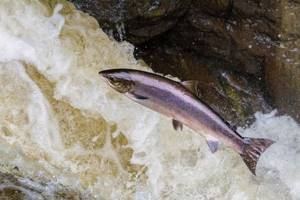
A characteristic feature of salmon, as well as salmon, trout, chum salmon, sockeye salmon and other species is the ability to adapt to living conditions. The appearance of males changes especially often before spawning. They acquire a bright red color and change body shape.
Salmon fish can be of different sizes: from several tens of cm to 2 m. The largest individuals can weigh up to 70 kg. But usually salmon and salmon do not grow more than 1 m and reach a size of up to 45 kg.
Features of lifestyle and nutrition
Trout, salmon, salmon, chum salmon and pink salmon live in the northern part of the Pacific and Atlantic oceans. There are many of them in the northern seas. Salmon are found in the rivers and lakes of Siberia, Yakutia, the Far East, Kamchatka, and some species live in Baikal. Trout or salmon can be found in Karelia, Lake Onega, and northern European countries. They are even bred in Norway.
Trout, salmon, salmon, chum salmon, and coho salmon prefer clean, oxygenated water. They can live in both sea and fresh water, but to reproduce they always go up the river. Therefore, they are classified as migratory fish. They spawn in autumn and winter until January. The favorable water temperature is 3-80.

This is the main feature of salmon behavior. Sockeye salmon, chinook salmon, salmon, coho salmon and pink salmon hatch from eggs in the river, grow and feed there. After a few years they go downstream into the sea. There they live until they reach sexual maturity. When it's time to spawn, they move upstream to the place where they were born. These representatives of salmonids die immediately after spawning.
Red salmon and salmon also go to spawn in fresh running water. But they can spawn 3-5 times without dying after laying eggs. Interestingly, the females prepare a place for laying eggs. They make depressions at the bottom, and cover the swept eggs with sand or pebbles.
Attention!
A peculiarity of all salmon fish is that before spawning they stop feeding. Their meat becomes tough, tasteless, and turns pale.
Usually all salmon are quite voracious. These are predators; they feed on small fish, mollusks, and crustaceans. The most popular species are herring, vendace, smelt and sand lance. Young salmon prefer zooplankton and crustaceans. The larvae of insects that have fallen into the water can also eat.
Types of salmon
Types of salmon The salmon family is a large fish family with several species:
- Char (American, Arctic, kunja)
. These are quite similar fish in appearance, differing only in their habitat. Loaches are called the orderlies of reservoirs - they feed on a wide variety of foods: from Pacific salmon caviar to stickleback. Char, in addition, is an object of fishing. - Pink salmon.
Pink salmon is a small silver-colored salmon, reaching no more than 50-60 cm in length. It feeds on fairly high-calorie food, consisting of fry, small fish and crustaceans. Pink salmon lives in almost the entire northern half of the globe, which has led to commercial interest in this fish - Ishkhan.
Ishkhan lives in Lake Sevan - another proof that salmon are able to adapt to any habitat. This is a most valuable delicacy fish, weighing up to 15 kilograms. - Chum salmon.
Far Eastern salmon or chum salmon is the sovereign master of the Pacific expanses. Massive chum salmon fishing is carried out both in Russia and the United States. Chum salmon caviar is quite large – up to 9 mm in diameter. - Coho salmon, Chinook salmon.
The white color of the scales gave these species other names - “silver salmon”, “white fish”. As for Chinook salmon, this is the king of salmon, as the Americans call this fish for its excellent taste. However, the fishing for this valuable salmon is very scarce due to its small numbers. - Christivomer North American.
This salmon lives only in lakes and has two forms: the cristomere, which lives on the surface of the water, and the cristomere, which lives on the bottom. - Brown trout.
Brown trout is listed in the Red Book of Russia. This is an anadromous salmon fish, valued for the amazing taste of its meat and caviar. The habitats of brown trout cover European rivers, the White, Baltic, Black and Aral Seas. - Lenok.
Lenok is more a fishing target for individual fishermen than for industrial fishing companies. This is a small salmon weighing two to three kilograms, although there are larger specimens - up to 8 kilograms. - Salmon (Clark's, Steelhead).
This salmon does not go far from spawning and tries to live in small channels. Its appearance is very exotic - for the red spots on its throat it was nicknamed the “cut throat” salmon. But this does not in any way affect the taste of the fish - it is excellent in any form. - Red salmon.
Sockeye salmon or red fish differs from other salmon in the color of its meat - it is deep red in color, and not pinkish. Sockeye salmon loves cold waters - it can rarely be found in water with a temperature of more than 1-2 degrees Celsius. - Salmon.
Noble salmon or salmon is a large salmon fish up to one and a half meters long and weighing up to forty kilograms. Unusually tasty tender meat made it a royal fish and one of the best fish delicacies. - Sima.
Mazu or Shima is a native of the Asian Pacific Ocean. This salmon is amazing: not only for the wonderful taste of its dense meat, but also for its ability to form residential freshwater forms as needed. - Taimen (Danube, Sakhalin)
. Taimen is a very large salmon fish, reaching 1.5 meters in length. It lives in large numbers in all rivers of Siberia and clean, cold lakes, preferring them to access to the open sea.
Salmon fishing
Salmon or trout are the most popular species for salmon fishing. But fishing is also common for other members of the family. Since they are strong and cunning predators, catching them is considered an extreme sport. This fish can jump high and swims very quickly.
It is very important for a fisherman to choose the right gear. Such a fish will not take a rough one, and besides, it has a weak mouth, so you need to use a fishing line. But it must be durable. It is recommended to fish with a spinning rod with a reserve of fishing line in the reel of at least 150 m. Rotating or oscillating spoons and wobblers are used as bait.
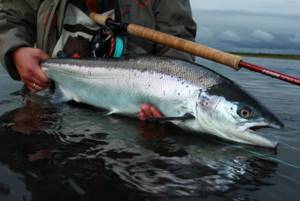
The best time to catch salmon on the sea or lake is in early spring and early summer. Around mid-June it has already been moving into the river. At this time, fishing is not so popular, since while salmon are in the sea, their meat is tastier. They feed more actively in cloudy weather, especially if there is a slight wave.
Distribution and habitats
Pacific salmon are found in the upper horizon of the world's oceans. Here this fish appears during the migration period. They swim here either from the depths or from the coastal shallows. Salmon come here to gain weight. And later he goes to spawn either back to the shallows, or into freshwater rivers or lakes where he was born.
Pacific salmon live in schools, forming huge biomass, sometimes even exceeding the number of permanent inhabitants of the ocean. The main representatives of Pacific salmon include chum salmon, pink salmon, coho salmon, chinook salmon and masu salmon. Most often, this fish comes to the northern part of the Pacific Ocean, where it gathers in huge schools and actively feeds. Pacific salmon go to spawn in the rivers of the Russian Far East, as well as in the reservoirs of Korea, Japan, North America and even Taiwan. At different times of the year, salmon live in different places, however, even with the onset of winter cold, they do not go further than subarctic waters.
Atlantic salmon, along with other species of this fish, are both resident and anadromous. Anadromous salmon are typically found in the North Atlantic Ocean. From here they go to spawn in many rivers, ranging from Spain to the Barents Sea. The lakes of Norway, Sweden, Finland and Russia are rich in the living form of this salmon.
Salmon are a very valuable commercial fish. Therefore, it is actively bred in fish farms. Some farms breed it for the purpose of organizing sport fishing, while others breed it for its taste. This is not surprising, because the meat of this fish is very tasty and tender, and is considered a delicacy. This fish is great for many types of dishes.
The nutritional value
Red fish is the most valuable source of Omega 3 unsaturated fatty acids. They slow down the aging process and improve memory. In addition, it contains many antioxidants, vitamins A, D, PP, B, phosphorus, chromium, and potassium.
Salmon are sold chilled, frozen, smoked or salted. A lot of different canned goods and preserves are also produced. Moreover, the variety is not always indicated. Therefore, it is difficult for many to determine which is better, salmon or pink salmon. It’s just that pink salmon is the most common red fish, so it’s more common.
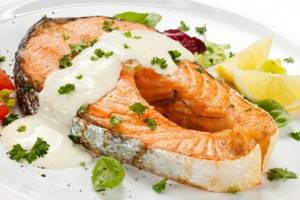
But what tastes better, salmon or salmon, can be determined unambiguously. It’s not for nothing that salmon is called the “queen of salmon.” It has fatty tender meat without a specific smell. In addition, it contains a lot of easily digestible protein and amino acids. Although many experts consider the question of which tastes better, salmon or salmon, to be incorrect. After all, salmon is often called salmon.
But you can figure out which fish is the fattest of all salmon. Chinook salmon, sockeye salmon and coho salmon contain the most fatty acids – from 6 to 11%. They have tender pink meat, quite high in calories and tasty. Chinook salmon is even called the “prince of salmon”, as it is tastier than other salmon.
But these varieties are rare, so consumers are often concerned with the question of which fish is fattier: salmon or trout. Here we can definitely answer that it is salmon. This is generally the fattest red fish - it contains 15% fat. Trout meat is a little dry, it contains only 4-5% fat, but it is more dietary and low-calorie.
Salmon is the name given to many fish of the salmon family. Usually this word is used in relation to salmon. But chinook salmon, coho salmon, sockeye salmon, chum salmon and pink salmon are also salmon.

